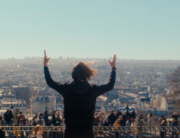
Miriam Makeba in Lionel Rogosin's COME BACK, AFRICA (Milestone Films/Film Forum)
![]() Come Back, Africa was one of the first films to expose black Africans’ life under apartheid to the world in 1959. But beyond its significance as a historical time capsule, the American premiere of the 2005 restoration, with fresh subtitles, reveals a striking exemplar of the political “docufiction” of director Lionel Rogosin. He expanded the skills he developed in combining the styles of Robert Flaherty and the Italian neorealists in his groundbreaking On the Bowery to focus on a searing international issue.
Come Back, Africa was one of the first films to expose black Africans’ life under apartheid to the world in 1959. But beyond its significance as a historical time capsule, the American premiere of the 2005 restoration, with fresh subtitles, reveals a striking exemplar of the political “docufiction” of director Lionel Rogosin. He expanded the skills he developed in combining the styles of Robert Flaherty and the Italian neorealists in his groundbreaking On the Bowery to focus on a searing international issue.
The black-and-white film intercuts actual scenes of the daily experiences of black Africans a decade into the increasing restrictions of apartheid within a barely fictionalized story of one man’s travails. Blacks are first seen pouring out of trains into the city each day, seeking work. Zachariah (played by genuine rural migrant Zacharia Mgabi) starts out at a gold mine, where he chafes at a misleading labor contract, the backbreaking work, crowded dorms, and meager pay. But his descriptions of the mines are not just talk—the grueling conditions are strikingly filmed. In the dark of the 24/7 operation, the only light above ground shines from the helmets of the endless line of miners going down to the sweaty confines of the underground dig, with no safety equipment. (In one of many subterfuges Rogosin used to obtain his extraordinary footage, he persuaded the manager that he was showing off the modernity of the mine.)
In the dorm, Zachariah learns of the twisted requirement that he can’t get other work in the city unless he has a pass, but he can’t get a pass unless he has a job. (This is before Catch-22 was published to give a label to such a bureaucratic conundrum.) But friends help him, as they do wherever he goes, so that Zachariah takes job after job before his pass expires. Even as some white employers are initially sympathetic, the racism of Afrikaners stymies him: a nasty, scolding housewife and her apathetic husband; a suspicious garage owner; a hotel manager anxious to keep his irrationally threatened guests happy; and a construction foreman with rigid rules, played by anti-apartheid activists with an authentic feel for the sharp vernacular in the improvised dialogue. As exceptional as it was to film with black African leads, the integrated cast alone made it an outlaw production.
Zachariah’s wife, Vinah (played by professional actress Vinah Bendile), illegally joins him in the city after leaving their famine-stricken farm, and they try to find some place to live together in the traditionally mixed-race Sophiatown, just as it was being razed to force blacks into more restricted areas further away. As the film became an elegy for the vibrant culture of Sophiatown while it was disappearing, music is a central and powerful element throughout. Rogosin used another approved cover story of showing “happy Africans” singing and dancing outdoors in street corner bands and community celebrations, and indoors in the smoky clubs called shabeens. One outstanding performance gained the film attention both for introducing the late Miriam Makeba to a wider international audience and for getting her banned from South Africa for 30 years. Young, strikingly beautiful, and talented, her two songs are electrifying. (Also screening in festivals in what would have been her 80th year is the informative biographical documentary Mama Africa that details the impact of this brief appearance on her life and career.)
The gatherings in the shabeen, where she casually entertains, are also the most overtly political scenes (if a bit stilted), as noted writers and intellectuals, including journalist Can Themba, dance, drink, and debate the impact of apartheid on the African National Congress (whose leaders were on trial), white liberals, and the rise of the local thugs known as tsotsis (even more here about black-on-black crime than in 2005’s Tsotsi). These pressures take a tragic and very emotional toll on Zachariah’s family that is as allegorical as it is moving.
The story behind the making of Come Back, Africa is as fascinating as what’s seen on screen. An American in Sophiatown, directed by Lionel’s son Michael (who was born in Johannesburg as the filming was being completed), is chock full of anecdotes in interviews with his parents and several of the film’s participants, as well as a tour of the bland walled suburb that replaced Sophiatown. It will be included on Milestone’s upcoming DVD release. In the 100th anniversary year of the ANC, the documentary series Have You Heard from Johannesburg, currently on PBS’s Independent Lens, shows how this landmark film fits in the overall context about South Africa, apartheid, and the international response for its deserved place in history.






Leave A Comment